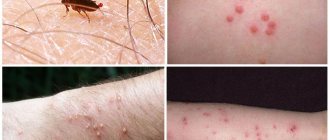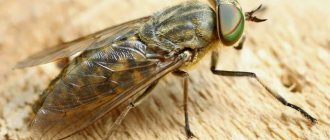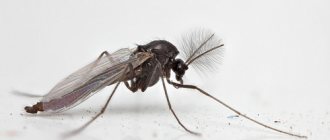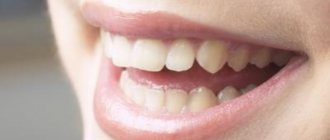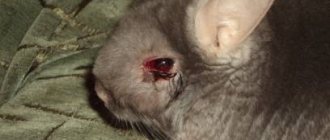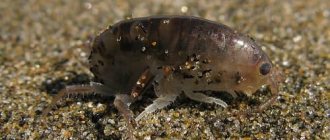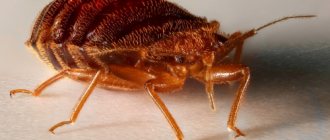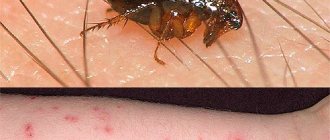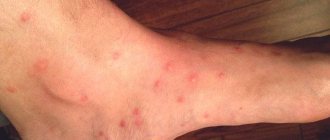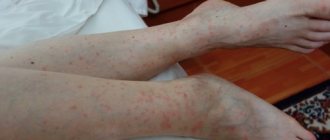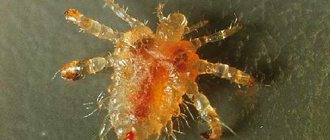Many people think that flea bites are harmless to humans, but usually those who have not encountered fleas think so. Insects harm not only pets, but also humans. Parasite bites are painful and that’s not all the consequences. When they bite, fleas pierce a person's skin, so dangerous viruses and infections can enter the body through the puncture. To avoid consequences, you must be able to recognize the symptoms of bites and know the rules for providing assistance.
Types of fleas
At the moment, about two thousand species of fleas are known to the world; they are divided into 200 genera and 15 families. Outwardly, they look almost the same, so it will be very difficult for an ordinary person to determine whether these insects belong to a certain species. A flea is a small insect, usually up to 5 millimeters in length, without wings, but with well-developed limbs. Due to their limbs, parasites can jump quite far for their size - up to 30 cm in length and 0.5 meters in height. Their body is brown, covered with a chitinous shell, their mouth looks like a pump, with the tip of which the flea pierces the human skin. After a bite, the flea injects a special enzyme into the wound that inhibits blood clotting. There is no anesthetic substance in the saliva of these insects, which is why the bites are painful and resemble a needle prick. The spines growing on the chitinous shell help fleas easily cling to animal fur, bird feathers and human hair. The flea's shell is quite strong, making it difficult to crush.
Do fleas bite humans?
Fleas mainly parasitize animals, but in isolated cases they can also attack humans. The fur of animals is a very comfortable place for blood-sucking creatures to live, which is why animals are preferable to people for fleas. Often fleas attack a person who has pets; the bites manifest themselves as itching and redness on the legs. The most common types of fleas found in a person’s home are:
- Dog and cat fleas. Usually dogs and cats bring them home after a walk.
- Chicken fleas. They jump on people after visiting a chicken coop, and they get on chickens from wild birds.
- Rat. They parasitize mice and rats. There is a theory that it was because of this type of flea that a terrible epidemic began in the 14th century, which claimed the lives of 25 million people.
- Domestic fleas, also called human fleas. Their bites are painful and attack both humans and animals.
- Earthen ones. Such fleas live in the surface layer of soil. When they enter a person's home, they settle in carpets, furniture and under baseboards. Basement fleas bite in places under or near the nail; female fleas can lay eggs under the nail plate; the finger in this place swells and begins to fester.
- Sand parasites. They live in sand, mainly in coniferous forests. Compared to other insect species, the sand flea causes the most problems. After a bite, it penetrates the skin and continues to live there.
If you find flea bites on your body, do not ignore this fact, but start fighting them. Some people underestimate the scale of the problem, but a flea can infect a person with fatal diseases such as typhoid, encephalitis, salmonellosis and others.
Main danger
For the first couple of hours, a small blister can be observed on the affected area, which subsequently resolves. Small hemorrhages also persist, so the victim walks with marks for several years. The body can react differently to insect saliva. For some, the itching and swelling go away after a couple of hours, while for others complications may develop, including:
- Pulicosis – thickening, hardening, prolonged redness. This dermatological disease is solely a reaction to human flea bites. It is characteristic that cat flea bites in humans do not cause such complications.
- Complex dermatitis - characteristic only in the case of permanent and extensive lesions.
- Anemia - can develop in young children as a reaction to changes in blood composition. By the way, cat flea bites on humans, as in the photo, do not lead to such a complication.
- An allergic reaction occurs specifically to the saliva of the parasite, as it contains many enzymes. Allergies develop when a person is hypersensitive to insect bites. In case of hypersensitivity, even a life-threatening condition such as anaphylactic shock cannot be ruled out, but the following reactions may occur: fever, breathing complications, diarrhea.
- Infections are the worst danger of these insects. In particular, they can cause diseases such as salmonellosis, typhus, encephalitis, hepatitis, and anthrax. Experts have identified about 200 pathogens of dangerous diseases in various types of fleas.
How to treat?
Naturally, if you have a flea bite, you should think about treating it. Examples of what these bites look like are shown in the photo. The first thing you need to know is to never scratch the affected areas. Damage to the skin at the site of the lesion is a kind of gateway for secondary infection. This can lead to suppuration of the wounds and the appearance of even more painful sensations.
There are many ways to get rid of flea bites on humans, and even at home. Alternatively, you can look at the photo and also read in our recommendations:
- First of all, you should wash the affected areas with an antiseptic. This could be a special bactericidal soap or lotion. You should not use warm water for rinsing, as it provokes itching;
- wash the affected area with black or green tea or simply apply a used tea bag to the itchy area;
- It is good to use tea tree oil to treat affected areas. It also helps relieve itching;
- To relieve swelling, you can apply a cold compress. Ice has proven to be good for relieving swelling. You can also remove frozen vegetables or meat from the freezer, wrap them in a napkin and apply to the painful area;
- If a flea bite on a person is swollen and red, as in the photo, then how to get rid of these symptoms? You will have to use special drugs. For example, ointment with hydrocortisone has proven itself well. This hormonal drug quickly and effectively relieves inflammation. It is enough to anoint with the product several times to make it easier.
You can see what else you can apply to flea bites on humans and where to buy the preparations in the table.
| Drug name | Description | Where can I buy? | Price |
| Nezulin | Ingredients: plant extracts and vegetable oils. The drug is completely safe even for small children. Quickly relieves swelling, redness, allergic reactions, as well as itching and irritation. | Pharmacies Stolichki, Moscow, st. Ussuriyskaya, 9 | 102 rub. |
| Psilo-balm | Contains a powerful antiallergic component, definhydramine, which blocks histamine receptors. Quickly relieves swelling and eliminates itching. | Carousel, St. Petersburg, Bolshevikov Ave., 32/1 | 248.6 rub. |
| Fenistil-gel | The antipruritic agent contains dimethindene maleate, which eliminates an allergic reaction in the form of redness, swelling, itching | Doctor Vremya, Minsk, Igumensky tract, 16 | 151600 rub. |
| Bepanten | The active component is dexpanthenol, an excellent wound healing and moisturizing agent. Can be used even for a newborn baby. | Intelex, Kyiv, st. D. Shcherbakovsky 56/7 | 105.47 UAH. |
- if the itching bothers you too much, it is recommended to consult a doctor who will prescribe some antihistamine by mouth;
- Also, for those who are interested in how to treat flea bites on humans, you can use aloe vera leaf. It’s good if you have this plant at home, but if not, you can use various gels containing this component;
- Another effective remedy for treating flea bites on humans is baking soda. Mix it with water and treat the wound. The photo shows that healing occurs quite quickly;
- You can use medicinal plants such as calendula or basil. Simply rub the leaves of the plants to release the juice and apply to the wound.
If all of the above methods are unsuccessful, treatment of flea bites in people does not bring a therapeutic effect, and even more so, the condition worsens, you should immediately visit a doctor.
It is worth remembering that the main condition for dealing with the problem is not treating the bites themselves, but getting rid of fleas in your apartment, house or beloved pet.
Features of pest control
It will not be possible to completely cure flea bites on the human body until measures are taken to neutralize them in an apartment or private house. If you do not remove pests, instead of one healed bite, several new ones will constantly appear.
Remember that bloodsuckers must be removed immediately, if only because they:
- They multiply rapidly. If no measures are taken, very soon fleas will take over the entire living space.
- They bite painfully, leaving itchy marks on the body. Flea bites are especially dangerous for children, as the risk of developing allergic reactions is high.
- They can spread various infections.
You can remove insects either independently or with the help of specialists. Let's look at both of these methods in more detail.
Help from professionals
The easiest way to quickly get rid of flea bites is not to use various ointments and other drugs on a person, but to remove them from the apartment. Most often, people turn to professionals for this. Why?
- it is very comfortable. There is no need to make any unnecessary movements. It’s enough just to find an office that deals with pest control in your city and invite a specialist to your home;
- it is affordable. You paid for the services, and the premises were treated with insecticides. For an additional fee, they can prepare your apartment for the procedure and clean it after the treatment;
- it's effective. Modern companies use imported effective and safe chemicals. In addition, most companies have a guarantee, before the expiration of which they will re-treat your apartment free of charge if necessary.
Let's see who offers flea removal and how much the service costs in different cities?
| Company name | Address | Telephone | Processing cost |
| Dez Mos | Moscow, Mruzovsky per., 1, building 4 | 7 | From 1800 rub. |
| Sanitary day | St. Petersburg, Elizarova Avenue, 3a | (812) 989-01-73 | From 1600 rub. |
| No insects | Novosibirsk, metro station Lenin Square | +7 | From 1500 rub. |
| Des Ural | Ekaterinburg, Ordzhonikidze Avenue 1, 4th floor | +7(343)302-06-98 | From 1500 rub. |
| Geradez | Nizhny Novgorod, st. Kuzbasskaya, 7A. | 8 | From 1300 rub. |
| Des Master | Kyiv, st. Kirilovskaya, 15 | (044)232-19-23 | From 650 UAH. |
| Preventive Disinfection Center | Minsk, st. P. Brovki, 11a | 292-13-03 | From 65400 rub. |
The services of professionals are simply necessary for residents whose apartments are located on the ground floor, and getting rid of fleas in this case is a criterion for comfortable living in the premises. After all, without treating the basements, it is impossible to destroy fleas in the apartment, and, therefore, it will not be possible to get rid of pest bites, even if a person uses the highest quality ointments. An important aspect that many are inclined to favor when turning to professionals is safety. The destruction of household pests by specialists is carried out using modern preparations, which for the most part do not have a strong odor. This means that even during treatment, occupants can remain indoors without the need for subsequent thorough cleaning. In addition, when using such drugs there are no symptoms of intoxication or allergic reactions in humans.
Self-processing
You can remove bloodsuckers yourself. The procedure is quite simple, but painstaking and time-consuming. In order not to think about what to anoint flea bites with, you need to solve three important problems:
- The most important thing is to determine the habitat of the parasites. This is necessary if you want to get rid of fleas forever. Carefully inspect the entire space of the apartment, which is located at a distance of 30-40 cm from the floor.
- Examine your pets to see if they are the cause of pests entering the premises. If cat flea bites are found on your pet’s body, then you will have to treat not only the person, but also the animal.
- Prepare everything necessary for processing the animal and the premises.
The procedure for removing parasites itself involves the following activities:
- absolutely all fabric items that are in the home must be removed, washed outside, washed with hot water, ironed, without missing a single seam;
- all blankets, pillows, mattresses must be treated with a steam generator, and then taken out onto the balcony or into the yard, leaving them for several days in the sun;
- all surfaces of the house should be washed thoroughly using a disinfectant;
- upholstered furniture and toys are thoroughly vacuumed. If possible, they also need to be taken out in the sun for a couple of days;
- all doors and windows are tightly closed, after which absolutely the entire room, including cracks and cracks, is treated with an insecticide;
- two to three hours after treatment, the room is ventilated, all surfaces are wiped with a damp cloth, then everything needs to be vacuumed;
- the paper bag from the vacuum cleaner must be thrown away;
- An animal living in the house also needs to be treated for fleas using insecticidal drops or shampoo. After this, it is advisable to put a flea collar on your pet.
The following insecticides are most often used when treating premises:
- Clean house;
- Raptor;
- Gett;
- Chlorpyrimac;
- Sinuzan;
- Biorin;
- Combat;
- Pyrethrum powder.
Causes of fleas in the house.
You can keep your home perfectly clean and tidy, but this does not guarantee that you will never get fleas. They can easily get into your home by clinging to your animal while walking. If you don’t have animals, then the following may be the case:
- Water pipes, basement, ventilation shafts.
- Door and window openings, cracks in the wall.
- Neighboring apartments.
- They can enter your home using your outdoor shoes.
- Attic, technical floor.
Please note that the discovery of even one flea is a reason to contact a special pest control service, because in fact the flea is not alone, its larvae and other relatives are hiding somewhere.
How do bloodsuckers get into bed?
Carpets, animal bedding, baseboards and dark corners are prime habitats and egg-laying sites for blood-sucking insects. Why are there fleas in bed linen? The owners themselves can bring parasites into the house on their clothes; in addition, these bloodsuckers are capable of moving independently over quite considerable distances; they move exclusively by jumping.
Blood-sucking insects may be in the house for the following reasons:
- If the apartment is located on the ground floor, then rodents living in the basements can introduce fleas.
- There are pets in the property next door to you.
- The parasites were brought in by the owners themselves, especially if we are talking about those who often have to visit basements or non-residential premises.
Bed fleas, photos of which are presented in this material, jump onto the bed solely to feed themselves. It is quite difficult to detect small insects, but if you make your bed with light-colored linen, you will certainly notice the presence of bloodsuckers.
How to recognize flea bites?
As mentioned above, flea bites are quite painful. Usually the reaction to bites manifests itself externally.
other signs.
Enzymes contained in insect saliva cause irritation, swelling and inflammation. Also, their saliva does not contain an anesthetic substance, so during a bite a person feels pain. Bite marks are usually located in small groups of 2-3 pieces, the distance between them does not exceed two centimeters. Fleas in the house live, as a rule, behind the baseboards and on the floor, therefore, a person’s feet suffer the most. People prone to allergies need to be especially careful. A flea bite in such people can cause serious deterioration in health, including difficulty breathing, increased body temperature, swelling of the lips and gastrointestinal upset. In this case, qualified medical assistance is simply necessary; without it, serious consequences can occur, for example, laryngeal edema, asphyxia, and even death. A healthy person can also develop an allergy from a flea bite; this phenomenon is called pulicosis
.
Here are the signs of pulicosis:
- A rash appears on the body.
- Inflammation, suppuration of the bite sites.
- Formation of ulcers in the mouth.
- Lymph nodes enlarge.
- The temperature rises.
- Headache.
If you find signs of flea bites, you first need to carefully consider the places in the house where insects may be hiding. Look especially closely at carpets, baseboards, and nooks where your pets live. If your assumptions are confirmed, you should consult a doctor, he will prescribe medications to heal the bites.
Why are flea attacks dangerous?
During a meal, the insect injects its saliva into the human wound, which contains a substance that promotes blood clotting. The penetration of the enzyme into the body provokes allergic reactions in people, and feces and undigested blood that come into contact with the skin during insect feeding aggravate the situation and cause additional skin reactions.
A single bite does not pose a serious danger to human health, which cannot be said about systematic, regular attacks by parasites. The consequences of flea bites can be very disastrous:
- Severe itching appears at the bite sites and when scratching there is a possibility of introducing microbes and infections into the wound.
- The manifestation of allergic reactions, which are accompanied by difficulty breathing, fever, intestinal disorders, hives, severe swelling of the skin. Frail children are especially prone to allergies. If you have dangerous symptoms, you should seek help from a doctor.
- Development of dermatitis, pulicosis.
- Infection of humans with endoparasites – worms, worms.
- Fleas are carriers of dangerous bacteria: plague bacillus, salmonella, encephalitis viruses, hepatitis, and typhus pathogens. In total, there are about 25 diseases that can be transmitted by insects.
In addition to being a health hazard, fleas cause psychological distress to their victims. A person develops psychosis, nervousness; it constantly seems to him that insects are crawling on him and biting him, even if at that moment there are no parasites.
The appearance of flea bites and how they differ from the bites of other insects.
Depending on the type of flea, their bites may be visually different from each other. Fleas living on rats and cats leave almost invisible marks; they are more like a regular allergy. Fleas that live on larger animals leave bites that become swollen and resemble bee stings. On average, swelling and redness from bites lasts up to two days.
There are practically no differences between the bites of fleas and other blood-sucking insects, which is why it is possible to confuse flea bites with mosquito bites. However, despite the external similarities, flea bites still have several characteristic features.
- Feeling pain immediately after being bitten
- The appearance of bruises under the skin
- The bites are located close to each other, in small groups.
- The main location on the human body is the legs.
Specifically, fleas differ from bedbugs in that fleas usually leave bites on the legs, while bedbugs infect the entire body. The location of bedbug bites resembles paths, while those of fleas are in a chaotic order. Bedbugs actively attack only at night, while fleas are active both day and night. The saliva of a bedbug contains an anesthetic, so a person does not feel its bites; fleas do not have such a substance and their bites cause pain.
Pharmacy drugs
Today, pharmacies offer a large selection of remedies to treat insect bites. The use of a particular drug should depend on the degree of damage to a person’s skin by parasites and the victim’s predisposition to allergic reactions. The most popular types of medications for treating flea bites include:
- antihistamines – relieve swelling and itching;
- ointments, gels, creams - heal the skin;
- balms – relieve redness and swelling;
- antibacterial solutions - disinfect combed areas of the skin.
Important!
Before using any pharmaceutical drug, you must carefully read the instructions. The active substances contained in medications may cause allergies or side effects.
Fenistil Gel
Ointments for flea bites
A popular ointment for flea bites and other insects has an antiallergic effect on the affected area. The active ingredient dimethindene reduces irritation and itching, eliminates swelling. Fenistil Gel has a cooling effect on the wound, thereby eliminating pain.
Medicines and remedies for flea attacks.
If you are attacked by fleas, then you need to take some measures to avoid the consequences of bites:
- Wash off the remaining particles of saliva and insect feces from the bite site; laundry soap and warm water will help you with this.
- Treat the wound with brilliant green, hydrogen peroxide, alcohol or vodka. We need something disinfectant.
- Applying a cold compress to the bite site will help reduce itching and relieve pain.
- Apply cream to the affected area, which you usually use after insect bites.
- Take an allergy medication to help prevent allergic reactions from developing.
After all activities, monitor the bites and the health of the affected person. If no signs of allergy appear, then you can continue to treat the bites yourself; if an allergic reaction occurs, be sure to consult a doctor, he will prescribe the appropriate treatment.
Medicines from the pharmacy.
The doctor will prescribe medications based on the symptoms and external manifestations of the allergy. Most often this is Fenistil gel, hydrocortisone ointment, Zvezdochka balm, Miramistin, Flucinar, Sulfur ointment.
Let's take a closer look at some of the drugs.
- Fenistil gel. A product that quickly and effectively relieves swelling and itching.
- Hydrocortisone ointment. A strong hormonal drug, it has side effects, so it is used only as a last resort.
- Star. The composition with menthol and eucalyptus will relieve pain and swelling. Rub it every half hour on the bite sites until the wounds heal. It is worth noting that the composition of the balm is quite aggressive; if the wounds begin to fester, then you cannot apply Zvezdochka.
- Miramistin. A good antiseptic, it will cleanse the skin of particles of flea saliva and prevent infections from spreading.
- Flucinar. Hormonal ointment, used in serious cases. Flucinar is contraindicated at the beginning of pregnancy, children under two years of age and after vaccinations.
- Sulfuric ointment. Sulfur has a disinfecting and antiseptic effect.
All of the drugs listed above have contraindications; before use, be sure to read the instructions and consult your doctor.
Traditional methods of treating bites.
If you currently do not have medications, you can use improvised means. Here are the recipes for compress solutions:
- Vinegar solution. Take a quarter liter of apple cider vinegar and half a liter of water. You can replace vinegar with citric acid.
- Soda solution. You will need a teaspoon of baking soda and one glass of water.
- Soda paste. To prepare it, add a small amount of water to the soda and stir until you get a paste. This paste helps neutralize the remaining toxins and infections after a bite.
- Dandelion juice. They wipe the bites several times a day.
- Aloe juice application. Effectively relieves swelling and reduces inflammation.
- Tea bag. Brew a tea bag and apply to the affected area for a few minutes.
How to relieve itching and eliminate inflammation?
Scratching the affected area can lead to infection entering the body. Treatment should begin by washing the wounds with cold water and soap. This will help relieve itching and remove parasite saliva. Ice will help relieve swelling and soothe the skin. A cold compress has the same effect. As a last resort, you can cauterize the bite sites with alcohol.
Natural Remedies for Treating Bites
It is worth using folk remedies only if there are no medications and the lesion is very small. This will help:
- Apple cider vinegar (0.25l) + water (0.5l);
- Soda (1 teaspoon) + water (1 glass);
- Apply a freshly brewed tea bag and leave for 5 minutes;
- The bite site can be treated with aloe vera juice;
- For severe pain, ammonia will help. One teaspoon should be diluted in a glass of water and applied to the affected area.
Apple cider vinegar can be replaced with lemon juice. You can self-medicate only if the bite does not cause an allergic reaction.
Pharmacy drugs
Special antihistamines can relieve severe itching. Most often they have a texture in the form of an ointment or gel.
Fenistil-gel
Thanks to its light texture, the drug is quickly absorbed into the skin. The cooling effect relieves severe itching, softens pain, and removes irritation.
Balm “Star”
This inexpensive drug is very popular. It soothes the skin and relieves pain after a bite.
Hydrocortisone ointment
The main advantage of this drug is blocking the allergic reaction. Apply the ointment to a fresh bite.
Miramistin
The product will help treat the affected area and reduce the risk of complications.
Flucinar
The drug relieves inflammation and relieves itching. They should be applied to the bite area to avoid an allergic reaction.
Sulfuric ointment
Sulfur ointment is the most affordable option. It will help disinfect wounds and reduce the risk of infection.
Consequences of bites in children.
Children's skin is thinner and more delicate, so flea bites in children are more likely to cause allergies than in adults.
The bite of even one individual can cause a phenomenon such as hives. The most common symptoms of an allergic reaction in children:
- High temperature that rises quickly
- Diarrhea
- Nausea
- Labored breathing
- Chills
- Anxiety
- Subcutaneous bruises and bruises
In addition, children are at risk for infections from bites because they scratch the wounds until they bleed and thereby contribute to infection.
It is extremely important to promptly block the development of allergies, because flea bites can cause serious illness. If you discover symptoms of tachycardia, swelling of the ears, lips and tongue, barking cough and difficulty breathing in yourself or your child, immediately take an antihistamine and call an ambulance. Antihistamines include Suprastin, Diazolin, Loratadine and others.
Preventive measures.
Preventing fleas is easier than fighting them. For prevention purposes, follow these simple recommendations:
- Cleanliness is the key to freedom from pests. Pay special attention to secluded places where it is difficult to clean.
- Fill all gaps in baseboards, window frames and doorways.
- Provide your animals with flea collars.
- Frequently and promptly wash the rugs on which your pets sleep and rest.
- Place bouquets of aromatic herbs in the corners to repel insects.
- Periodically wipe all surfaces in the house with a soda solution.
If you find at least one individual flea, do not put off fighting them until later, call a special pest control service.
